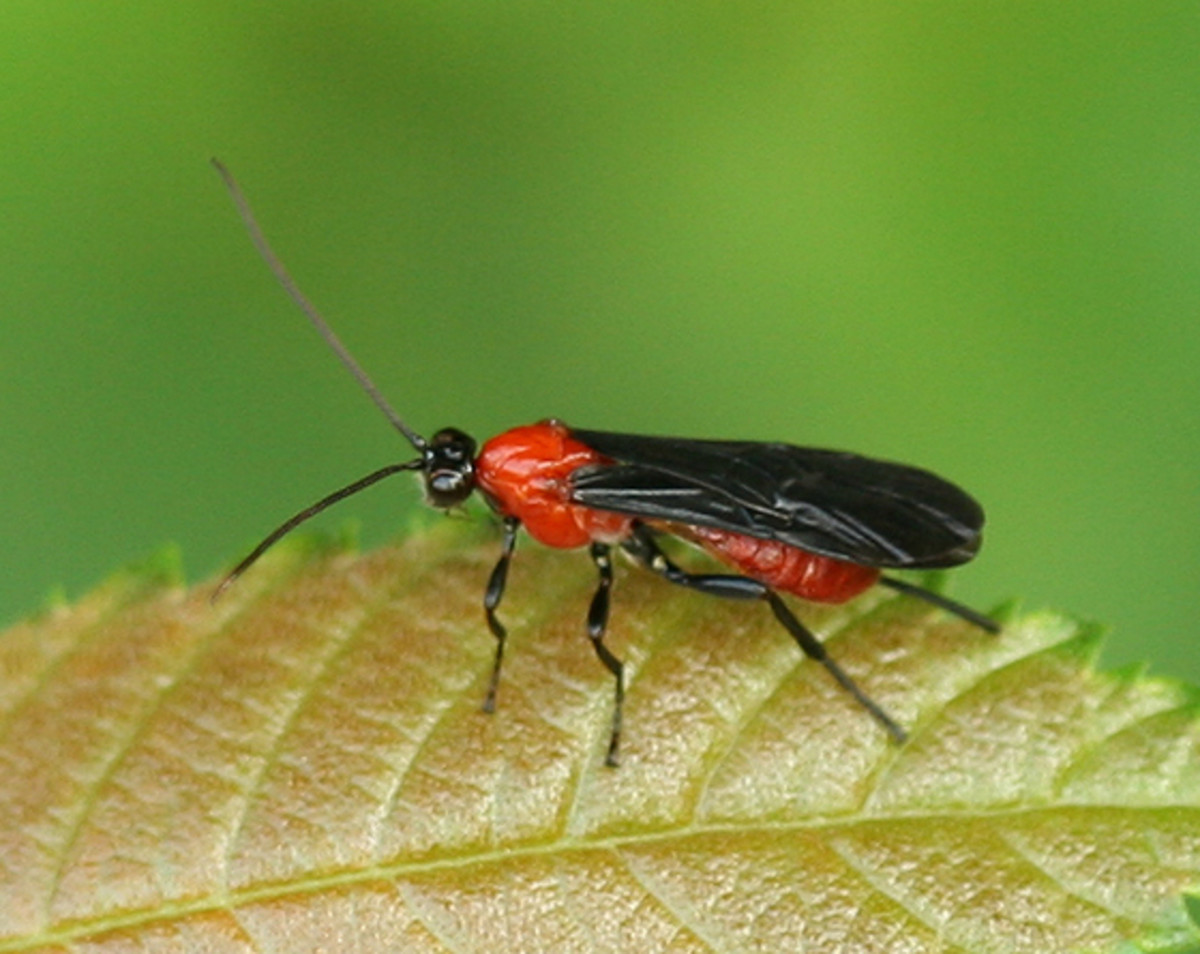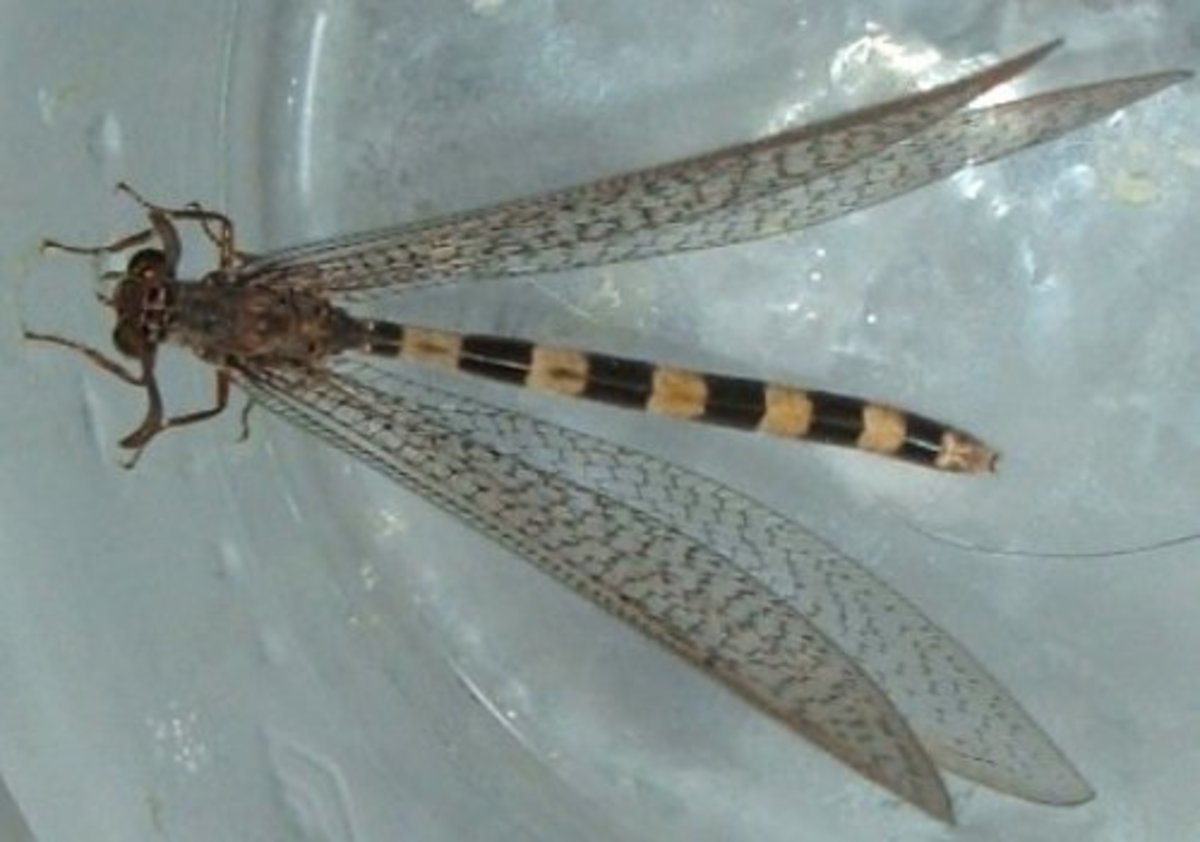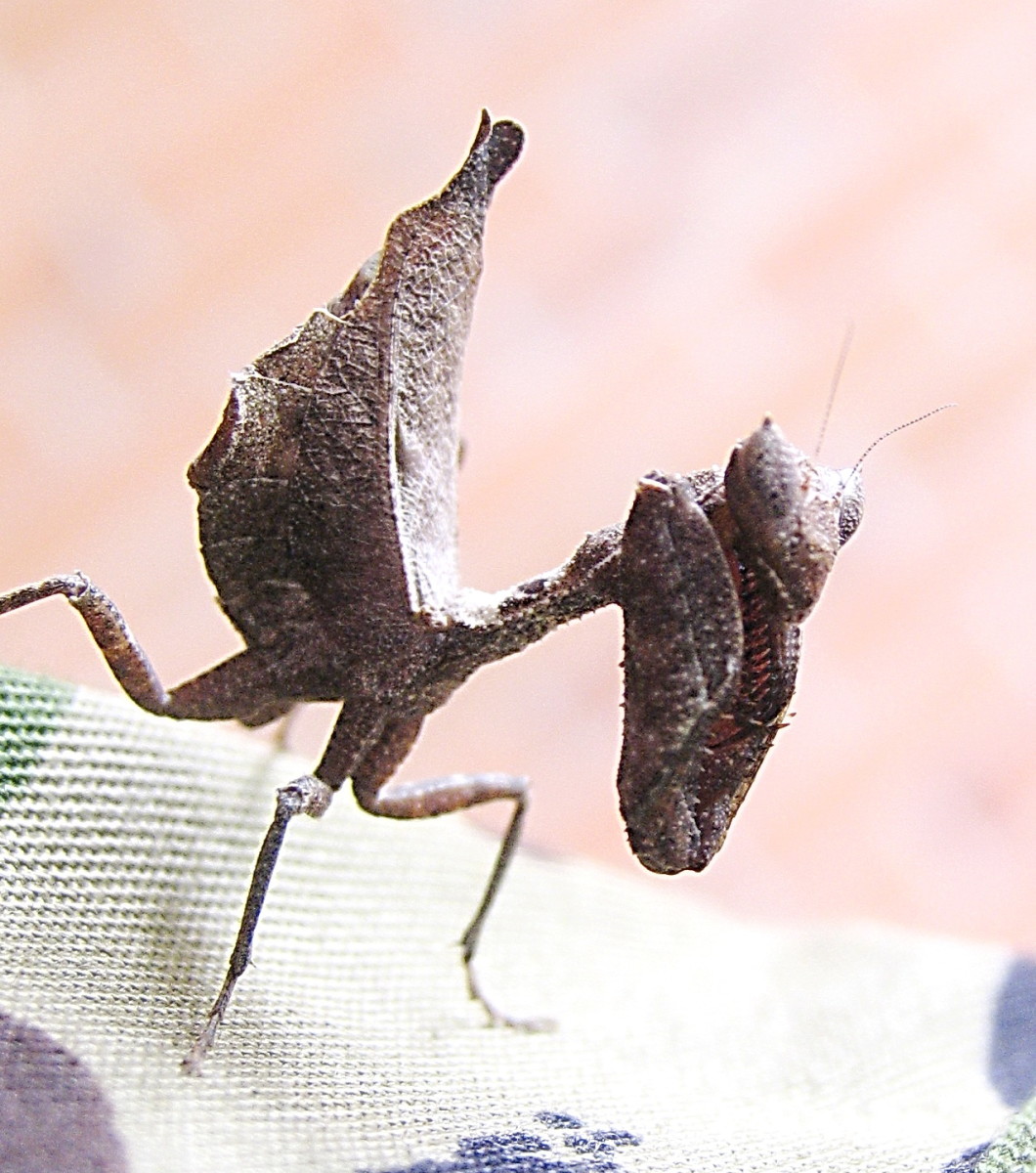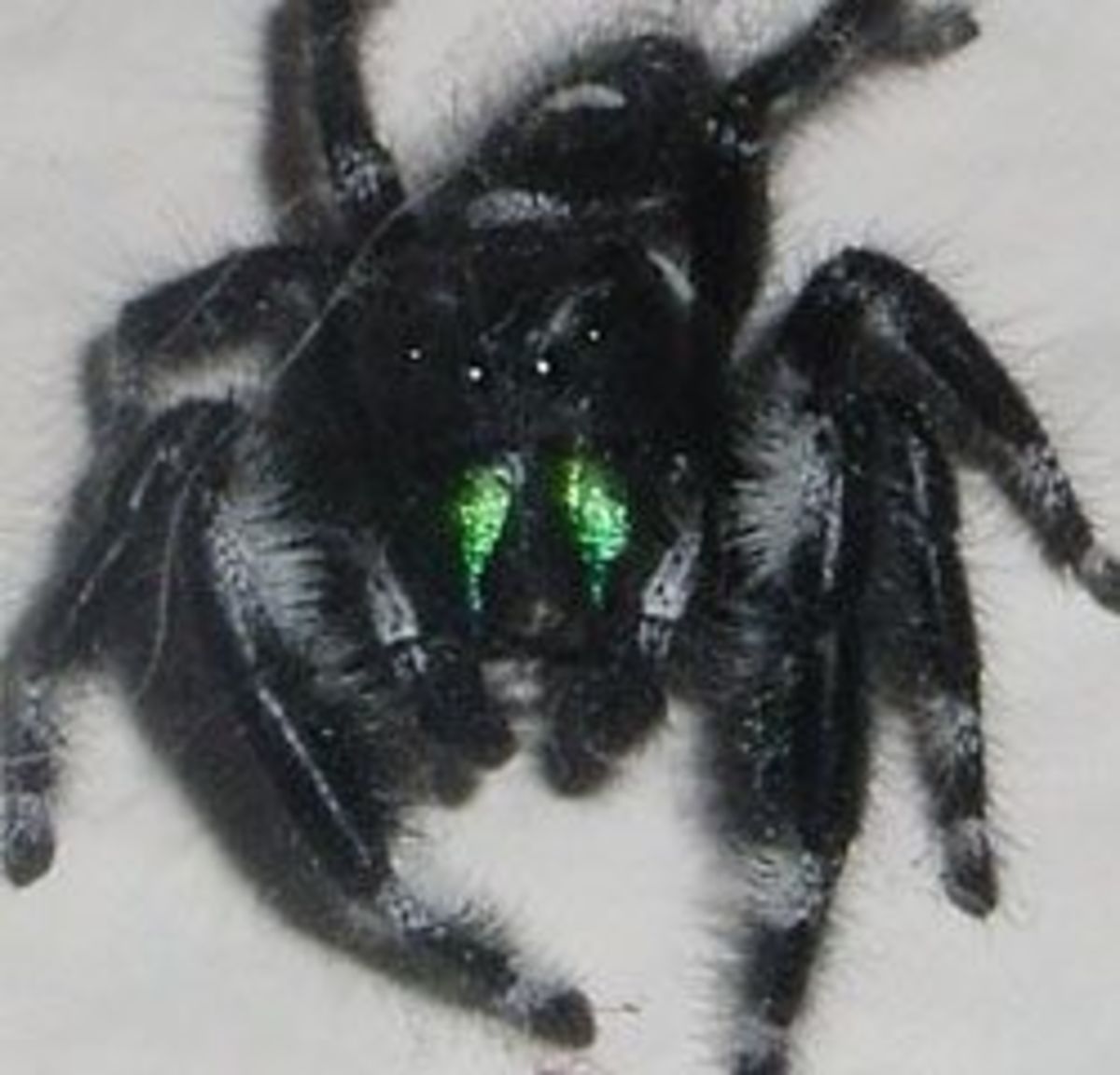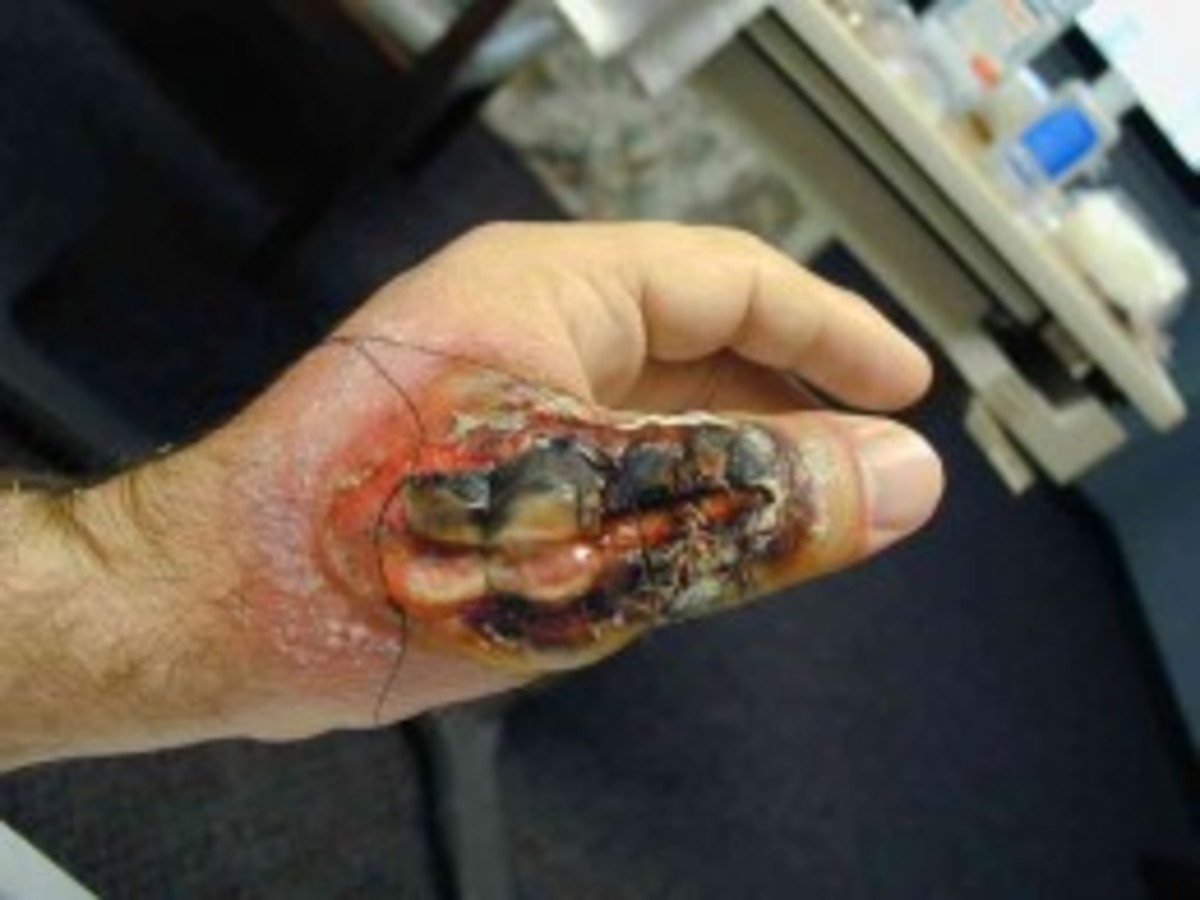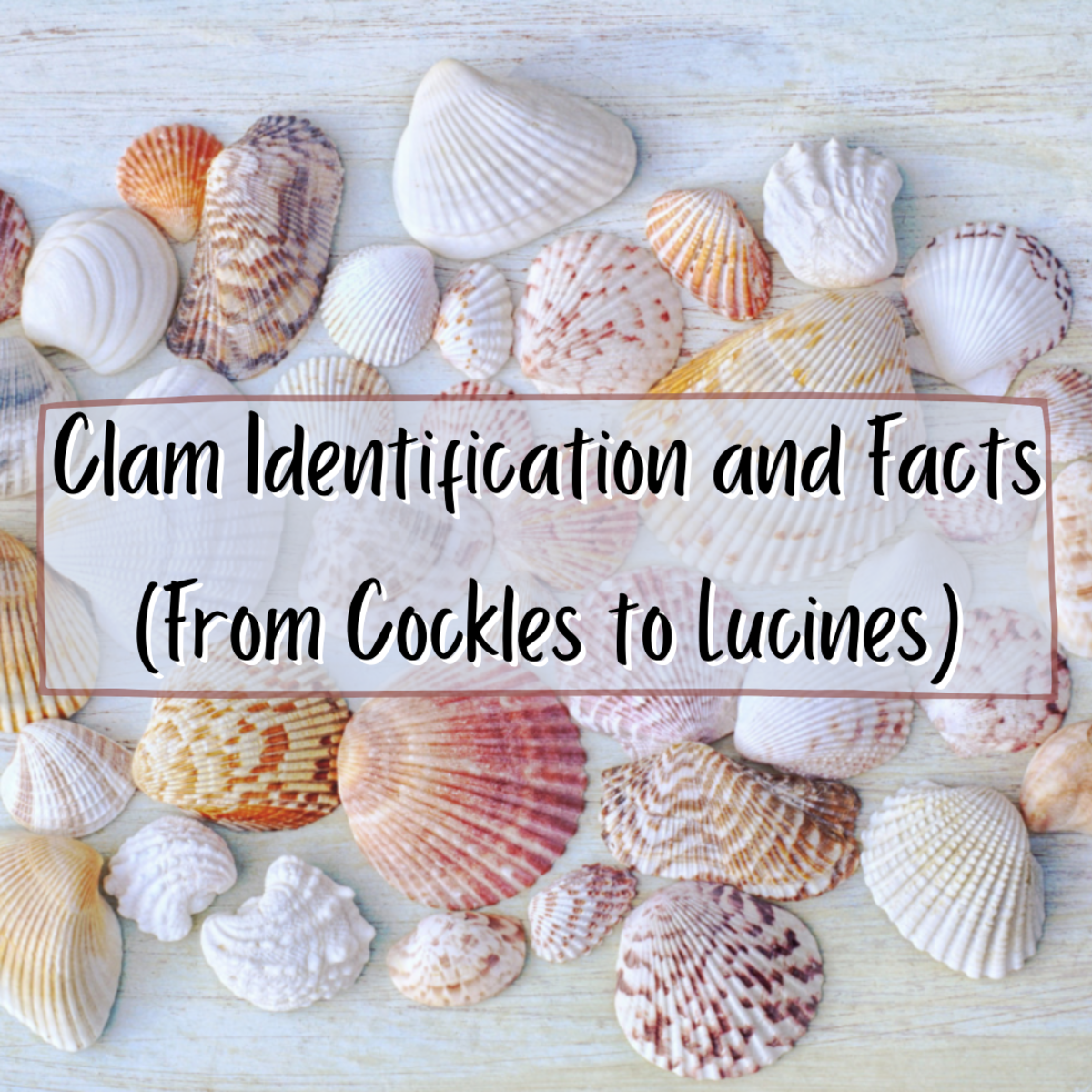THE SECRET LIFE OF BUGS (in my Garden)
What is so secret about the life of bugs? Read on to find out!
Aside from flowers and raindrops, another thing that I usually focus on with my camera are bugs.
Various bugs inhabit my small garden but compared to flowers, they usually are harder to take pictures of because they move around a lot. So, most of my photos of bugs are either chance encounters or “stalker” encounters.
Chance, because they happen to be on the flower that I am taking a picture of or “stalker”, because I purposely wait out for them as they go about their business. Either way, I always feel elated if I come up with some clear shots.
So here are the bugs I encountered in my garden.
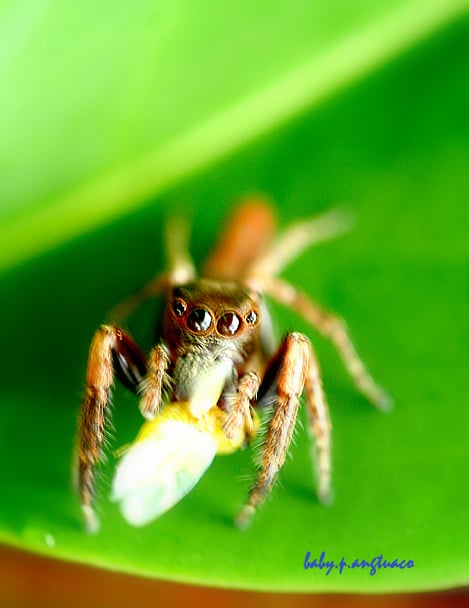
SPIDERS
There are at least 3 (maybe more) different kinds of spiders in my garden.
Before I started focusing on them with my camera, I didn’t know much about spiders. The only thing I know is that they are not insects but arachnids.
Insects have 3 pairs of legs while spiders or arachnids have 4 pairs. I was therefore surprised when I discovered that most spiders have 4 pairs of eyes too. Isn’t that neat? Aha, I bet you did not know that too!
The picture on the right is a jumping spider. It belongs to the family Salticidae . Members of this family do not build webs for capturing prey. Rather, they prowl around and stalk their prey, then when ready to capture, they jump or pounce on them.
If you look at the photo, you will see that this spider has a pair of large center eyes and another pair beside them. With eyes this big, you can be sure that this spider is a hunter. Just look at the insect that it is holding on its jaws. By the way, this spider also has two other pairs of eyes. One pair is behind the center eyes and the other is along the sides of the head. These additional pairs of eyes are not seen in this photo however.
The number as well as arrangements of eyes in spiders is usually used as a basis for their classification.
If you want to know more about spider eyes then click on this link: http://bugguide.net/node/view/84423
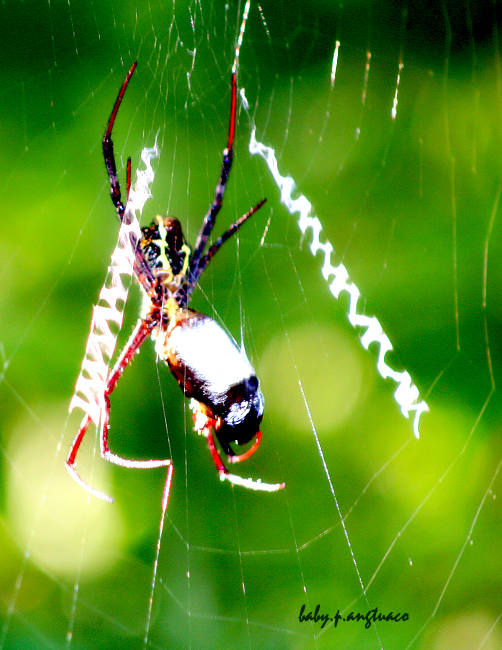
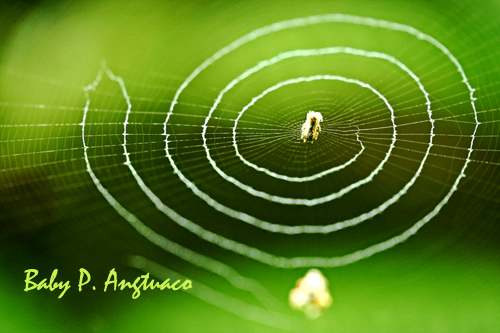
This is an orb weaver spider. Unlike the jumping spider, orb weavers do make webs that are usually spiral or rounded in shape, thus their name – orb weaver.
Although orb weavers also have 4 pairs of eyes, these are not very prominent like those of the jumping spiders. They therefore capture their prey with their web. If you notice, the captured beetle is even much bigger than the spider.
Notice too that the web has some white decor on it. Compare this with the décor of this other web. Aren’t they something?
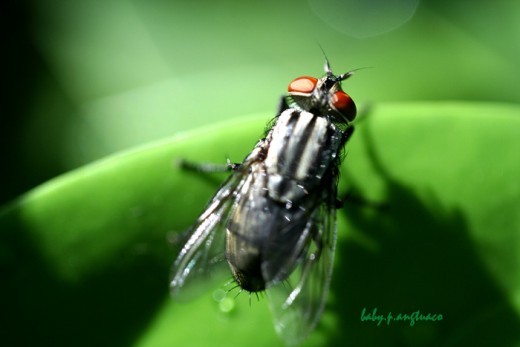
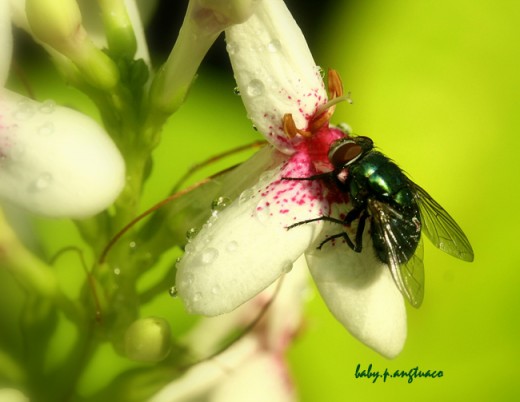
FLIES
I’ll be the first one to admit that I don’t like flies. I always swat them every time I see them especially when inside the house. However, I must also admit that it’s nice to take pictures of flies because they not only have colourful eyes, but they also stay still, long enough for you to take some good shots.
There are many different kinds of flies. You are most likely familiar with the common housefly (Musca domestic) or the fruit fly (Drosophila melanogaster) and the blowfly (Calliphora sp.). And of course you are familiar with the mosquito which by the way is also a fly.
Flies and mosquitoes belong to the same insect order, Diptera, or true flies.
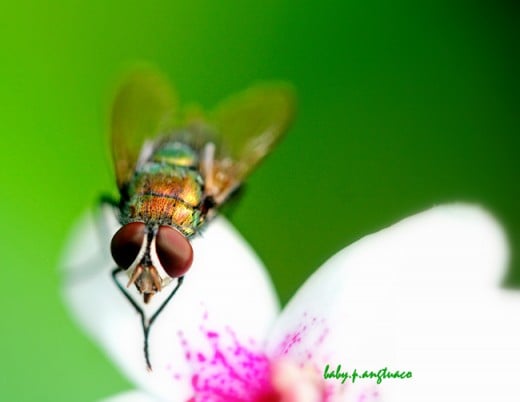
Blowflies are bigger and more colourful than the ordinary housefly. This is why they are also called bluebottles or greenbottles depending on their color. Since flies feed only on liquid food, I usually chance upon them on flowers or some decaying material.
By the way, did you know that blowflies are valuable tools in forensic science? Yes, they are!
In forensics, after 72 hours or 3 days, it is usually hard to tell how long a body has been dead. Since blowflies can smell decaying flesh from long distances, they are usually the first ones to visit and lay their eggs on the dead being. This is the reason why blowflies are also called carrion flies. Then, since the life cycle of blowflies is very predictable, you can always tell how long a body has been dead by looking at the stage of the life cycle of the blowfly. Depending on the species, blowflies can transform from egg to pupa between 5 to 11 days.
According to Wikipedia, - “the name blowfly comes from an older English term for meat that had eggs laid on it, which was said to be fly blown” (http://en.wikipedia.org/wiki/Blow-fly).
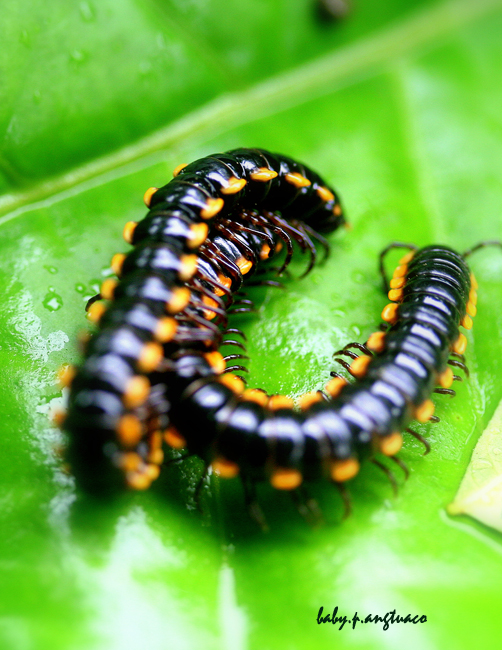
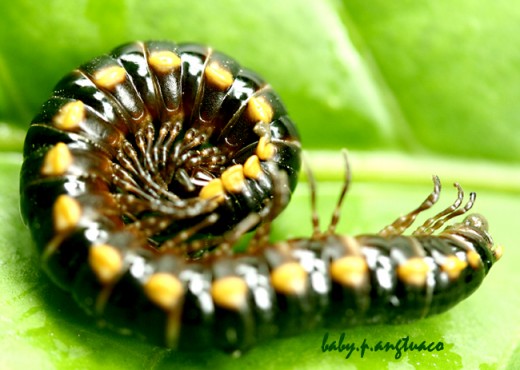
MILLIPEDES
Millipedes abound in my garden during the rainy months. I always see them slowly moving around inch by inch either alone or with a partner. Yes, they still move around even as they mate! If you try to touch them, they will immediately curl up in defense.
Unlike centipedes that are predators and dangerous, millipedes only feed on decaying leaves. Thus they can be kept as pets if you care for them as such.
You can distinguish millipedes from centipedes through the number of legs per segment as well as through the speed of their movement.
Millipedes have two pairs of legs per body segment while centipedes only have one pair. Millipedes also move very slowly (inch by inch as I mentioned earlier), while centipedes move fast. That's why the latter are predators. They can even attack animals twice their size.
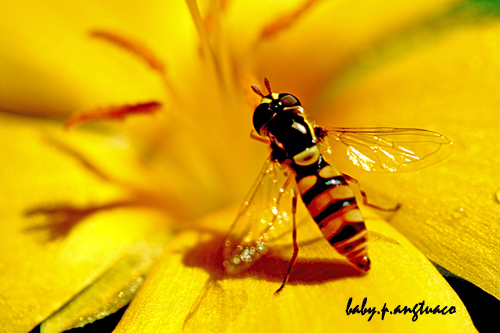
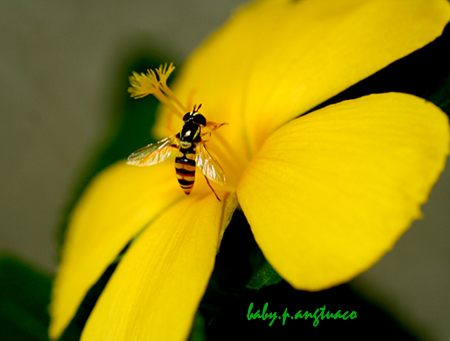
BEES
There are always plenty of bees buzzing in my garden. However they rarely stay long enough to enable me to take their picture. Thus, when I chanced upon this resting bee one day, I just clicked and clicked away.
One other thing that prevents me from having more bee photos is – I am wary about getting close to them. I am allergic to bee sting, you see!
I discovered this painfully when I
was in high school. One bee stung me on my forehead and my whole face as well
as arms became swollen! I looked like a monster from outer space for a few days
then! Ugh! Shhh...this is a secret!
By the way, the idea that bees die after they sting is only true if their victim is a mammal or a bird. The barb in their sting lodges in the victim’s skin and will tear loose from the bee’s abdomen as it tries to fly away. Thus, the bee soon dies after this.
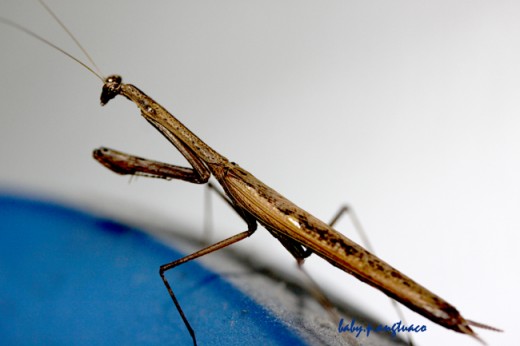
PRAYING MANTIS
The “prayer stance” of the praying mantis is due to the folding of its front legs. This is clearly seen in the picture to the right. I found this mantis inside our house “praying” on top of a clock (the blue thing in the photo). What this mantis was praying for on top of our clock remains as a puzzle to me to this day!
By the way, the front legs of the mantis have barbs. The barbed legs are used to strike and hold the prey securely. Once a prey is captured, the mantis almost always goes right for the “neck” much like going for the “jugular” in mammals.
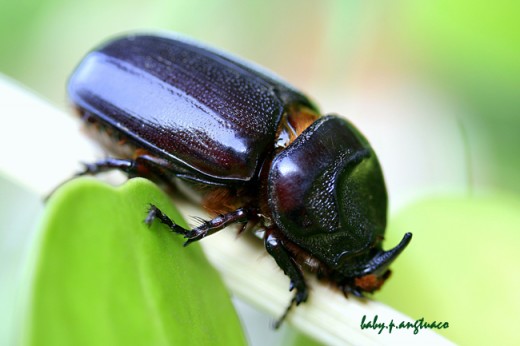
BEETLES
I have seen at least 3 kinds of beetles in my garden. However, I was only able to get a picture of this rhinoceros beetle.
It is obvious why this beetle has this name. The horn like structure on its head is very prominent. This is used by male beetles for fighting with other males during the mating season. Because of this behavior, it is not surprising then that they are kept as pets and “beetle fights” are staged as a form of gambling especially in some parts of Asia.
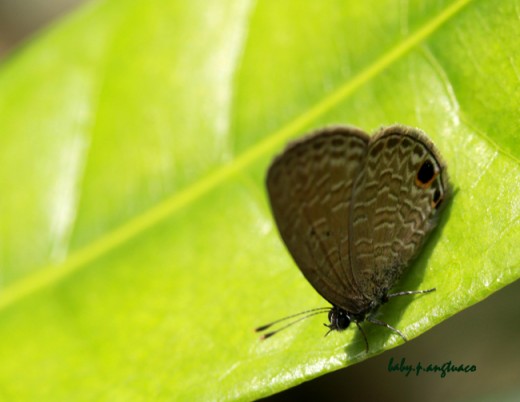
BUTTERFLIES and MOTHS
Taking photos of butterflies is very challenging because they fly around all the time. So even if I have seen several species of butterflies flying in my garden I do not have any collection of butterfly pictures. I only have this photo plus the one I used in my hub on courtship strategies in animals: http://hubpages.com/hub/Courtship-Strategies-What-We-Can-Learn-From-Animals
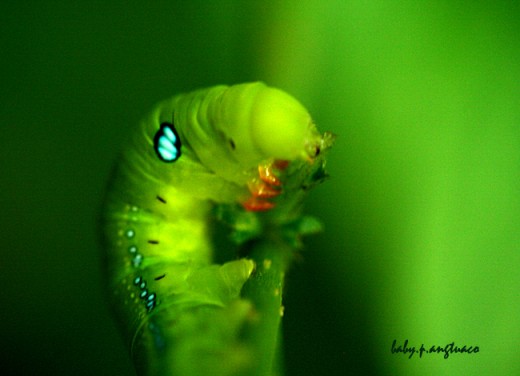
CATERPILLAR
If taking pictures of butterflies is hard, taking photos of their larva, the caterpillar, is a cinch.
Caterpillars are so fat and slow moving. They are rather hard to notice because their color usually blends with the leaves they gorge on. This caterpillar on the right certainly is proof that "you are what you eat". Don't you agree?
ANTS
Ants are amazing creatures such that it’s always fascinating to watch them. I already devoted one hub to them: http://hubpages.com/hub/Amazing-Ants
I am sharing here just one favourite photo. You can’t imagine how long I waited for the ants to get into this position so I can take this photo!
When a friend saw this photo, she commented "Awww, how sweet!"
Actually, these ants are not kissing but exchanging info about food!
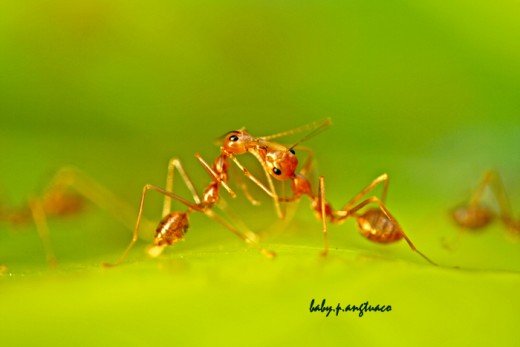
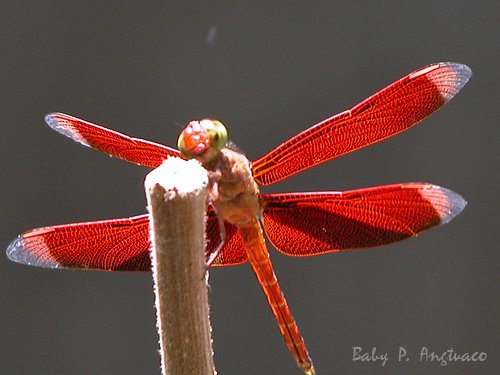
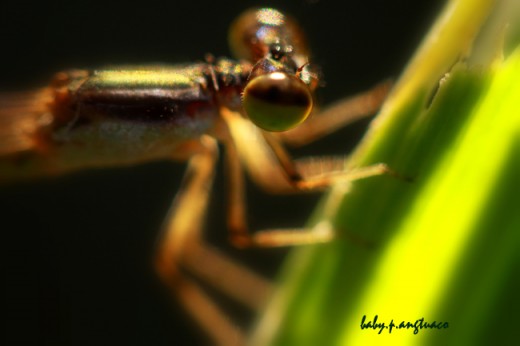
DRAGONFLIES and DAMSELFLIES
Dragonflies and damselflies are also hard to pin down for a photo session. So my photos of this group are almost always chance encounters. I always have to click fast before they fly somewhere else.
I was actually taking shots of ants when I chanced upon this damselfly. I was afraid it would fly away (it actually did) if I still change my camera settings and my position, so I just clicked away. This is why I was only able to catch its head.
The secret to distinguishing a dragonfly from a damselfly is through the position of their eyes and wings.
In dragonflies, the eyes are right on top of their head and are very close to each other while the eyes of damselflies are separated from each other. When resting, the wings of dragonflies are spread away from the body while that of the damselflies are held close to the body.
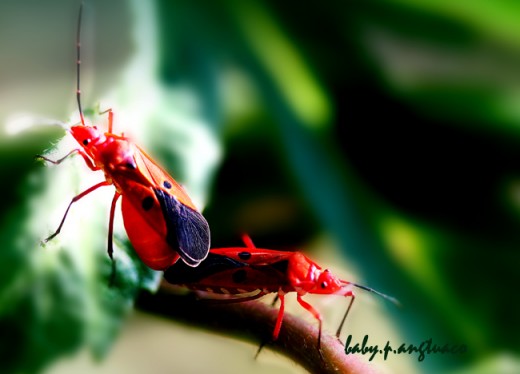
SEED BUG or MILKWEED BUG
The last bug I will share here is the seed bug or milkweed bug. It belongs to the order, Hemiptera which is considered as the order of true bugs. Also included in this order are water striders, water bugs, and assassin bugs.
True bugs are those insects that have a triangular marking behind their head. Also, their mouth parts are modified into piercing and sucking structures. We can thus see them sucking either plants or other insects.
By the way, these insects do not undergo metamorphosis. That means their young do not go through larval and pupal stages. Instead their young hatch directly from the eggs as young adults called nymphs.
More Bug Secrets
There are still several insects and bugs in my garden. However, I haven’t had a chance to take their pictures yet.
There are several termites for example. I haven’t taken their photo though because every time I see them I just feel like crushing them to smithereens! Why? Because they ate volumes of my favourite books and some clothes, that’s why!
Ok, enough of that. Here’s something to end this hub on a light note.


